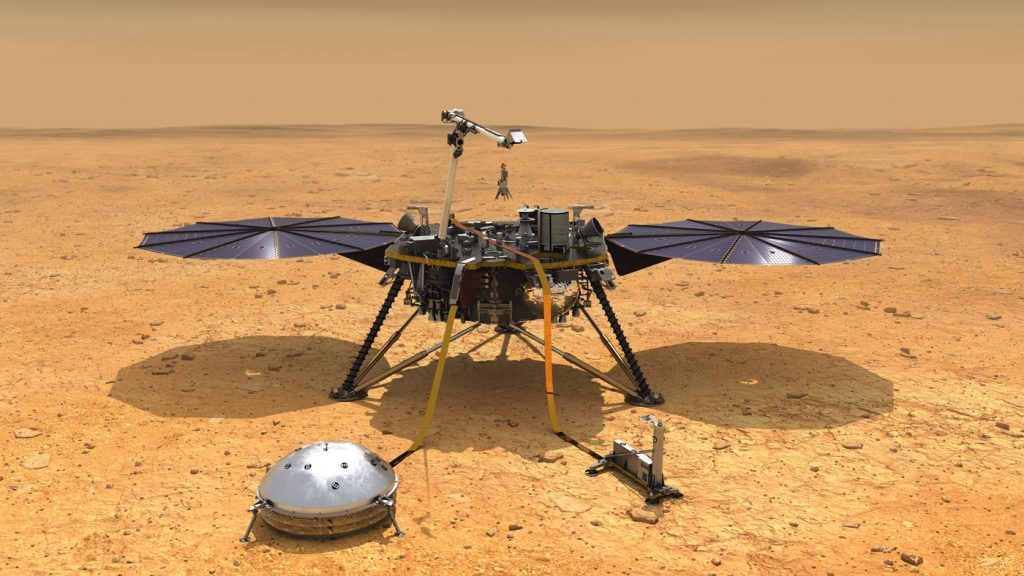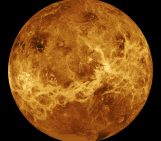
Drawing inspiration from popular stories on our social media channels, major geoscience headlines, as well as unique and quirky research, this monthly column aims to bring you the latest Earth and planetary science news from around the web.
Major stories
Earth’s red and rocky neighbor has been grabbing a significant amount of attention from the geoscience media this month. We’ll give you the rundown on the latest news of Mars.
The NASA-led InSight lander, short for Interior Exploration using Seismic Investigations, Geodesy and Heat Transport, touched down on the Red Planet’s surface last week, causing the space agency’s Jet Propulsion Laboratory (JPL) control room to erupt in applause, fist pumps, and cool victory handshakes.
The lander, equipped with a heat probe, a radio science instrument and a seismometer, will monitors the planet’s deep interior. Currently, no other planet besides our own has been analysed in this way.
While scientists know quite a bit about the atmosphere and soil level of Mars, their understanding of the planet’s innerworkings, figuratively and literally, only scratches the surface. “We don’t know very much about what goes on a mile below the surface, much less 2,000 miles below the surface down to the center,” explains Bruce Banerdt, a scientist at JPL, to the Atlantic.
By probing into Mars’ depths, researchers hope the mission gives insight into the evolution of our solar system’s rocky planets in their early stages and helps explain why Earth and Mars formed such different environments, despite originating from the same cloud of dust.
“Our measurements will help us turn back the clock and understand what produced a verdant Earth but a desolate Mars,” Banerdt said recently in a press release.
The InSight lander launched from Earth in May this year, making its way to Mars over the course of seven months. Once reaching the planet’s upper atmosphere, the spacecraft decelerated from about 5,500 to 2.4 metres per second, in just about six minutes. To safely slow down its descent, the lander had to use a heatshield, a parachute and retro rockets.
“Although we’ve done it before, landing on Mars is hard, and this mission is no different,” said Rob Manning, chief engineer at JPL, during a livestream. “It takes thousands of steps to go from the top of the atmosphere to the surface, and each one of them has to work perfectly to be a successful mission.”

This artist’s concept depicts NASA’s InSight lander after it has deployed its instruments on the Martian surface. Credit: NASA/JPL-Caltech
The InSight lander is currently situated on Elysium Planitia, a plane near the planet’s equator also known by the mission team as the “biggest parking lot on Mars.” Since landing, the robot has taken its first photos, opened its solar panels, and taken preliminary data. It will spend the next few weeks prepping and unpacking the instruments onboard.
The devices will be used to carry out three experiments. The seismometers will listen for ‘marsquakes,’ which can offer clues into the location and composition of Mars’ rocky layers. The thermal probe will reveal how much heat flows out of the planet’s interior and hopefully show how alike (or unalike) Mars is to Earth. And finally, radio transmissions will demonstrate how the planet wobbles on its axis.
In other news, NASA has also chosen a landing site for the next Mars rover, which is expected to launch in 2020. The space agency has announced that the rover will explore and take rock samples from Jezero crater, one of the three locations shortlisted by scientists. The crater is 45 kilometres wide and at one point had been filled with water to a depth of 250 metres. The sediment and carbonate rocks left behind could offers clues on whether Mars had sustained life.
What you might have missed
By analysing radar scans and sediment samples, a team of scientists have discovered a massive crater, hidden underneath more than 900 metres of ice in northwest Greenland. After surveying the site, scientists say it’s likely that a meteorite created the sometime between 3 million and 12,000 years ago.
The depression under Hiawatha Glacier is 31 kilometres wide, big enough to hold the city of Paris. At this size, the crater is one of the top 25 largest craters on Earth; it’s also the first to be found under ice. An impact of this size significant mark on the Earth’s environment. “Such an impact would have been felt hundreds of miles away, would have warmed up that area of Greenland and may have rained rocky debris down on North America and Europe,” said Jason Daley from Smithsonian Magazine.
Links we liked
- A 100,000+ year ice age in less than 2 minutes? Check out this great visual history of glaciation in the Alps.
- ‘Magma shift’ may have caused mysterious seismic wave event
- Why 536 was ‘the worst year to be alive’
- Ancient Romans polluted their lakes just like we do today
The EGU Story
This month, we have announced changes to the EGU General Assembly 2019 schedule, which aim to give more time for all presentation types. Check our news announcement for more information. In other news, we have opened applications to the EGU General Assembly 2019 mentoring programme, and are advertising a job opportunity for geoscientists with science communication experience to work at the meeting.
Also this month, we opened the call for applications for EGU Public Engagement Grants, and have announced the creation of the EGU Working Group on Diversity and Equality. Finally, we’ve published a press release on a new study that looked into whether data on seabird behavior could be used to track the ocean’s currents.
And don’t forget! To stay abreast of all the EGU’s events and activities, from highlighting papers published in our open access journals to providing news relating to EGU’s scientific divisions and meetings, including the General Assembly, subscribe to receive our monthly newsletter.




